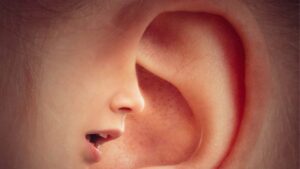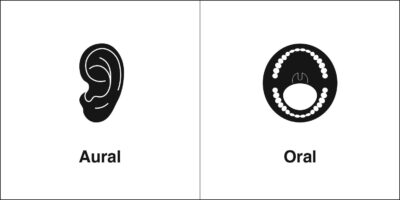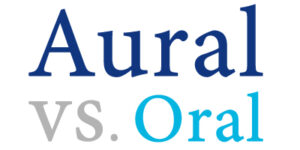The contrast between ‘aural’ and ‘oral’ resides at the heart of our sensory and communicative experiences. While both terms are closely associated with perception and communication, they delineate distinct realms: one centered on the act of listening and understanding, and the other on the art of speaking and articulation.
Understanding the nuances between aural vs oral unveils the intricate interplay between our capacity to absorb information through sound and our ability to express thoughts and ideas verbally. Let’s delve into the depths of these terms to unravel their significance in our daily interactions and cognitive processes.
Importance of distinguishing between aural and oral
Distinguishing between “aural” and “oral” is important because these terms are related to different sensory experiences and have distinct meanings in various contexts.
- Aural:
-
- Meaning: Relating to the sense of hearing or the ear.
- Usage: Aural is often used in the context of music, sound, or any auditory experience. For example, “aural skills” refer to the ability to perceive and analyze sounds, pitches, and tones in music. Aural examinations may test one’s ability to identify and understand sounds.
- Oral:
-
- Meaning: Relating to the mouth or spoken language.
- Usage: Oral is associated with spoken communication or anything related to the mouth. For instance, “oral hygiene” refers to practices that promote the cleanliness of the mouth, such as brushing teeth. In an educational setting, an “oral presentation” involves spoken communication as opposed to a written report.
Understanding the distinction between these terms is crucial in various fields:
- Education: In educational settings, teachers may use “aural” to refer to listening skills and “oral” to refer to spoken language skills. This differentiation helps in designing appropriate teaching and assessment methods.
- Music and Arts: Musicians and music educators often focus on developing aural skills to enhance listening and musical understanding. This is distinct from oral skills, which may involve singing or speaking in a musical context.
- Healthcare: In healthcare, distinguishing between “aural” and “oral” is crucial when discussing issues related to the ear or the mouth. This clarity is essential for accurate diagnosis and treatment.
- Communication Studies: Professionals in communication studies or linguistics may use these terms to differentiate between skills related to hearing and skills related to speaking in the study of oral communication.
While these terms may sound similar and are related in the broader context of human senses, distinguishing between aural and oral is essential for clear communication and for accurately addressing specific aspects of hearing, speaking, and related activities.
Aural
Aural experiences encompass the vast and intricate realm of the sense of hearing. The term “aural” pertains to anything related to the ear or the perception of sound. This sensory domain is crucial in our daily lives, influencing our understanding of the world around us, connecting us to music, language, and the ambient noises of our environment.
Auditory Perception: Aural perception involves the brain’s interpretation of sound waves, enabling us to distinguish between various pitches, tones, and rhythms. The complexity of auditory perception allows us to appreciate the intricacies of music, discern spoken language, and be alert to potential environmental cues.
Music and Aural Pleasure: One of the most profound aspects of aural experiences is the enjoyment of music. Music, with its diverse melodies, harmonies, and rhythms, has the power to evoke emotions, trigger memories, and create a unique auditory landscape. The aural pleasure derived from music is a universal phenomenon that transcends cultural boundaries.
Soundscapes: The world is filled with diverse soundscapes, from the rustling of leaves in a forest to the bustling noises of a city. Aural experiences extend beyond simple sounds, incorporating the context and environment in which they occur. These soundscapes contribute to our overall perception of spaces and can influence our moods and emotions.
Language and Communication: Aural communication is fundamental to human interaction. The ability to comprehend spoken language and convey messages through sound is essential for effective communication. From casual conversations to artistic expressions, aural elements play a crucial role in conveying meaning and fostering connections.
Technological Impact: Advancements in technology have significantly influenced aural experiences. From the invention of musical instruments to the development of sophisticated audio recording and playback devices, technology has expanded the possibilities for creating, sharing, and experiencing sound in ways unimaginable in the past.
Challenges in Aural Health: Ensuring the health of our ears is paramount for maintaining a rich aural experience. Issues such as hearing loss, tinnitus, and other auditory impairments can impact our ability to fully engage with the auditory world. Awareness and proactive measures are essential for preserving a healthy aural environment.
In essence, the aural dimension enriches our lives in multifaceted ways, from the joy of music to the nuanced understanding of spoken words. It serves as a vital thread that weaves through our daily experiences, connecting us to the vibrancy and diversity of the world of sound.
Let’s delve into examples that illustrate the diverse facets of aural experiences:
Music:
- Genres and Styles: From classical symphonies to contemporary pop, music showcases the breadth of aural creativity. Beethoven’s Symphony No. 9, for instance, evokes powerful emotions through its orchestration and choral elements.
- Cultural Diversity: Traditional music from different cultures, such as Indian classical ragas or West African drumming, demonstrates how aural experiences vary globally.
Soundscapes:
- Nature Sounds: Imagine the calming rustle of leaves in a forest, the rhythmic crashing of ocean waves, or the chirping of crickets at night. These natural soundscapes contribute to our sense of place and well-being.
- Urban Environments: The cacophony of a bustling city—honking cars, footsteps, conversations—creates a distinct urban soundscape that reflects the pulse of city life.
Speech and Language Perception:
- Multilingual Environments: In multicultural settings, people navigate aural experiences shaped by the diversity of languages spoken. The ability to distinguish and comprehend different languages highlights the intricacies of aural communication.
- Speech Patterns: Unique speech patterns, accents, and intonations contribute to the richness of aural communication. For example, the melodic cadence of a Southern drawl in the United States contrasts with the rapid staccato of New York City speech.
These examples showcase the broad spectrum of aural experiences, from the emotional depth of music to the immersive nature of soundscapes and the intricate nuances of speech and language perception. Each of these elements contributes to the complex and interconnected tapestry of our auditory world.
Oral
When you mention “oral,” you’re likely referring to aspects related to spoken language, verbal communication, or anything pertaining to the mouth, speaking, or oral traditions. Here’s a breakdown:
Oral Communication:
- Verbal Expression: Oral communication is the primary mode of human interaction involving spoken words. It encompasses conversations, speeches, storytelling, and discussions.
- Non-verbal Cues: Oral communication isn’t solely about words. Non-verbal cues such as tone, pitch, gestures, and facial expressions significantly influence the message’s interpretation.
Oral Traditions:
- Storytelling: Throughout history, cultures worldwide have preserved their heritage through oral traditions. Stories, myths, legends, and folklore passed down verbally carry cultural values, history, and moral lessons.
- Historical Narratives: Before the advent of writing, oral tradition served as the primary means of passing historical events and knowledge from one generation to another.
Oral Health:
- Dental and Mouth Care: Oral health focuses on maintaining the well-being of the mouth, teeth, and gums. This includes practices like regular brushing, flossing, and dental check-ups to prevent oral diseases.
- Speech Therapy: Addressing speech impediments or communication disorders through specialized therapy and exercises falls under oral health care.
Oral Examinations and Presentations:
- Educational Context: In academic settings, oral exams and presentations assess students’ ability to articulate their thoughts, present information coherently, and engage with an audience.
- Professional Communication: Presentations, speeches, and discussions are vital in professional environments for conveying ideas, persuading audiences, and fostering teamwork.
Oral Literature and Performances:
- Poetry and Spoken Word: Oral literature encompasses poetic forms and spoken word performances that celebrate the beauty and power of language through oral expression.
- Theater and Oratory Arts: Theatrical performances, debates, and oratory events rely on oral delivery to captivate and engage audiences.
The “oral” domain spans various aspects of human life, encompassing verbal communication, cultural preservation, health care, education, and artistic expression. It highlights the significance of spoken words, storytelling, and the profound impact of effective verbal communication in shaping societies and individuals.
Let’s delve into texampleshat illustrate the diverse facets of Oral experiences:
Conversations:
- Casual Dialogues: Everyday conversations between friends, family members, or colleagues showcase the spontaneity and adaptability of oral communication. Topics can range from daily experiences to personal matters.
- Interviews: Job interviews, journalistic interviews, or research interviews rely heavily on oral communication to assess qualifications, gather information, or share perspectives.
Speeches:
- Inspirational Speeches: Speeches like Martin Luther King Jr.’s “I Have a Dream” or Winston Churchill’s wartime addresses exemplify the power of spoken words to inspire and motivate large audiences.
- Informative Speeches: TED Talks and academic lectures demonstrate how effective oral communication can convey complex information in an engaging and accessible manner.
Presentations:
- Business Presentations: Professionals often use oral communication to deliver business proposals, project updates, or sales pitches during presentations.
- Educational Presentations: Teachers and lecturers use oral communication to impart knowledge and facilitate learning through classroom presentations.
- Conference Presentations: In academic and professional conferences, experts present their research findings, insights, and innovations through oral presentations.
These examples highlight the versatility of oral communication in various contexts, from everyday conversations to formal speeches and presentations. Effective oral communication involves not only the choice of words but also elements like tone, body language, and engagement with the audience, all of which contribute to the successful transmission of ideas and information.
Aural vs Oral: Key Differences
“Aural” and “oral” are two terms that are often confused due to their similar pronunciation. However, they have distinct meanings and applications:
- Aural:
-
- Meaning: Relating to the sense of hearing or the ears.
- Usage: Aural is used to describe things related to the ear or the sense of hearing. For example, aural communication involves information perceived through listening, and aural skills refer to the ability to recognize and interpret sounds.
- Oral:
-
- Meaning: Relating to the mouth or spoken word.
- Usage: Oral pertains to things related to the mouth or spoken language. Oral communication involves conveying information through speech, and oral hygiene refers to the care of the mouth and teeth.
Challenges in developing aural skills
Developing aural skills, which involve the ability to perceive and interpret sounds, especially in the context of music, language, or other auditory stimuli, can present various challenges. Here are some common challenges associated with developing aural skills:
- Limited Exposure to Diverse Sounds:
- Challenge: Limited exposure to a variety of musical genres, languages, or other auditory experiences can hinder the development of aural skills.
- Solution: Actively seek out diverse auditory experiences, listen to different types of music, practice listening to various languages, and engage with a broad range of soundscapes.
- Lack of Formal Training:
- Challenge: Without formal training, individuals may struggle to understand complex musical structures, intervals, or tones.
- Solution: Enroll in music classes, language courses, or workshops that focus on developing aural skills. Having a structured learning environment with a knowledgeable instructor can be beneficial.
- Difficulty in Identifying Tonal Elements:
- Challenge: Discerning pitch, intervals, chords, and other tonal elements can be challenging, especially for beginners.
- Solution: Practice with exercises specifically designed to enhance recognition of tonal elements. Use tools such as ear training apps or software that provide interactive exercises.
- Limited Listening Focus:
- Challenge: Inattentive listening or distractions can impede the development of aural skills.
- Solution: Practice active listening by concentrating on specific elements in music or spoken language. Eliminate distractions and regularly engage in focused listening exercises.
- Difficulty in Transcription:
- Challenge: Transcribing music or spoken language accurately can be difficult for those developing aural skills.
- Solution: Start with simple melodies or short phrases and gradually progress to more complex compositions. Use transcription tools or software to check accuracy and improve over time.
- Inconsistent Practice:
- Challenge: Irregular or infrequent practice may slow progress in developing aural skills.
- Solution: Establish a consistent practice routine. Regular, short practice sessions are often more effective than sporadic, longer sessions. Set achievable goals and gradually increase the complexity of exercises.
- Difficulty in Recognizing Rhythmic Patterns:
- Challenge: Recognizing and reproducing rhythmic patterns can be challenging.
- Solution: Practice rhythmic dictation exercises, clap or tap along with music to internalize rhythms, and use metronomes to improve timing and precision.
- Overcoming Personal Biases:
- Challenge: Personal preferences or biases may impact the ability to appreciate and understand diverse auditory stimuli.
- Solution: Challenge yourself to explore and appreciate various genres, styles, and cultures. Embrace a broad perspective to enhance overall aural sensitivity.
Overcoming these challenges requires patience, consistent practice, and a willingness to explore and expand one’s auditory experiences. Working with a teacher or using specialized resources can also significantly aid in the development of aural skills.
Challenges in developing oral skills

Developing oral skills, which involve effective spoken communication, can pose several challenges. These challenges may vary depending on the context, such as language learning, public speaking, or interpersonal communication. Here are some common challenges associated with developing oral skills:
- Language Barriers:
-
- Challenge: For language learners, expressing ideas in a new language can be challenging due to limited vocabulary, grammar knowledge, or unfamiliar pronunciation.
- Solution: Regular language practice, immersion, and seeking feedback from native speakers can help overcome language barriers. Utilize language learning apps, engage in conversations, and practice speaking in various situations.
- Fear of Public Speaking:
-
- Challenge: Many individuals experience anxiety or fear when speaking in public, which can hinder effective communication.
- Solution: Gradual exposure to public speaking, practicing in front of a mirror or with a supportive audience, and joining speaking clubs or workshops can help build confidence and reduce anxiety.
- Lack of Clarity and Articulation:
-
- Challenge: Articulating thoughts clearly and maintaining coherent speech can be difficult, especially when under pressure or nervous.
- Solution: Practice articulation exercises, slow down speech when necessary, and focus on concise expression of ideas. Recording and reviewing oneself can also provide valuable insights.
- Poor Pronunciation:
-
- Challenge: Pronunciation difficulties may arise due to differences in accent, lack of exposure, or insufficient awareness of phonetic patterns.
- Solution: Work on pronunciation through language classes, language exchange programs, or with the help of pronunciation guides. Regularly listening to native speakers can improve accent and intonation.
- Ineffective Listening Skills:
-
- Challenge: Effective oral communication involves not only speaking but also active listening. Poor listening skills can lead to misunderstandings and miscommunication.
- Solution: Practice active listening by giving full attention to the speaker, asking clarifying questions, and paraphrasing to confirm understanding. Developing empathy can also enhance overall communication.
- Difficulty Organizing Thoughts:
-
- Challenge: Organizing thoughts coherently and presenting them in a structured manner can be challenging, leading to rambling or unclear communication.
- Solution: Develop the skill of outlining key points before speaking. Practice delivering organized presentations and work on structuring thoughts logically to enhance overall coherence.
- Overcoming Shyness or Introversion:
-
- Challenge: Shy or introverted individuals may find it challenging to initiate and sustain conversations.
- Solution: Gradual exposure to social situations, setting small communication goals, and practicing interpersonal skills can help overcome shyness. Building self-confidence is crucial for effective oral communication.
- Cultural Differences:
-
- Challenge: Communicating across cultures may present challenges due to differences in communication styles, norms, and non-verbal cues.
- Solution: Cultivate cultural awareness, seek to understand cultural nuances, and adapt communication styles accordingly. Learn about different cultural expectations to enhance cross-cultural communication.
Overcoming these challenges requires a combination of self-awareness, targeted practice, and a willingness to step out of one’s comfort zone. Seeking feedback from peers, mentors, or language instructors can also provide valuable insights for improvement in oral communication skills.
Conclusion
This page reveals all you need to know about aural vs oral. While “aural” and “oral” may sound similar, they represent distinct aspects of human perception and communication. “Aural” pertains to the sense of hearing, involving the interpretation of sounds, music, and spoken language.
On the other hand, “oral” relates to the mouth and spoken communication. Both sets of skills—aural and oral—are essential in various contexts, such as language learning, music appreciation, and effective verbal communication.
Developing proficiency in these skills requires targeted practice, exposure to diverse stimuli, and a commitment to continuous improvement.


 Image credit
Image credit
